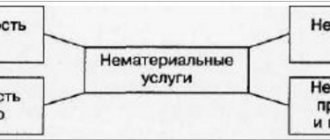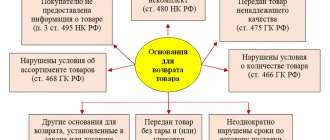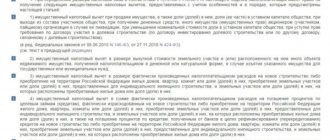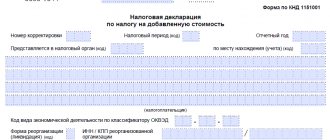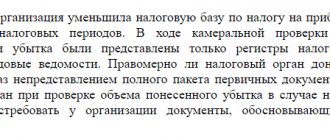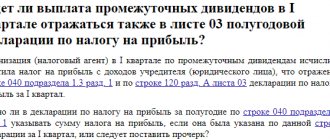Home — Articles
Returning goods is fraught with accounting difficulties. And everyone tries to avoid them. It's good if your customer returned the item quickly, while you can still delete the shipping data in your accounting without consequences. In this case, many (by agreement with the counterparty) simply destroy the shipping documents - and it’s as if the shipment never happened at all. And if the buyer returns only part of the goods, then a new invoice and invoice are issued only for those goods that remain with the buyer.
But this cannot always be done. You will then have to account for this return. The main catch is that for VAT purposes and for income tax purposes, the procedure for processing return transactions recommended by regulatory authorities is different. Moreover, no matter what goods are returned - high-quality or not.
If the recipient works according to the general system, and the returning party works according to the simplified one (without VAT)
Since the returning party (buyer), including individual entrepreneurs, is a non-payer of VAT, then in the event of a reverse sale, it does not issue an invoice.
But then the seller has a problem: when delivering the product, he issued an invoice, registered it in the sales book and set VAT to be paid to the budget after the money for the supply was received.
It is necessary to take into account that in such a situation, revenue increases. Therefore, you need to carefully monitor its level so as not to lose your right to the simplified tax system. This issue becomes even more serious for simplified companies that pay VAT on income. For them, the operation of returning products is absolutely unprofitable, since they do not take expenses into account when calculating the amount of tax.
If the buyer returns low-quality products using the simplified tax system, then this fact is recognized as the cancellation of the previous transaction. This circumstance is not reflected in tax accounting. The cost of products is not included in expenses , and returned funds will not be recognized as income. From an accounting point of view, this is a return of the advance.
In this case, the seller (i.e., the receiving party) must issue adjustment invoices as established in Decree of the Government of the Russian Federation No. 1137 of December 26, 2011. After this, the document is registered in the purchase book, therefore, the right arises to accept this amount for deduction.
What wiring are installed?
Reverse sales will be taken into account by the seller as follows::
- Dt 41 – Kt 60 – returned goods are accepted into the warehouse.
- Dt 60 – Kt 51 – funds returned.
- Dt 19 – Kt 60 – VAT specified in the adjustment document is reflected.
- Dt 68 – Kt 19 – VAT accepted for deduction.
The buyer's accounting will be as follows::
- Dt 51 - Kt 62 - reflects the receipt of funds for products sent back.
- Dt 44 – Kt 19 – input VAT is charged to expenses.
If a defective product is returned, this fact should be documented as follows::
- Dt 76 (sub-account for settlements of claims) – Kt 60 – the return is reflected.
- Dt 51 – Kt 76 (sub-account for settlements of claims) – funds were credited to the account.
Read about the intricacies of processing the return of expired and defective, high-quality and unsold goods to the supplier, as well as alcoholic beverages, including through EGAIS on our portal.
Is a declaration completed in this case?
The supplier must report both the initial shipment and the subsequent transfer back on the tax return. In the first case, the amount is taken into account in lines 010-020 of section III, in the second - indicates the deduction in line 120 of section III.
A buyer who is not a value added tax payer does not fill out a declaration.
How to report income tax?
If the reverse transfer took place in the same reporting period, then when filling out the income tax return, the seller should simply exclude these amounts from the revenue and expense lines (lines 010 and 030 on sheet 02 “Tax calculation”).
When the shipment period is already closed, this amount must be taken into account as expenses for the main activity and indicated in line 010 of Appendix 2 to Sheet 02.
Since the buyer is on a simplified system, he does not fill out this declaration.
Answers to common questions about accounting for customer returns
Question #1:
The seller transferred to the buyer goods that do not comply with the terms of the assortment agreement. The buyer returned the goods in the next reporting year, when the seller had already made accounting entries about the sale of the goods. Did the seller correctly recognize the income?
Answer:
Yes, the full amount of income is recognized legally. There is no need to make corrections - you need to make records of the return of the goods and the transfer of money to the buyer in the month when it became known about the return of the goods.
Question #2:
When to recognize a loss if the seller received the goods back due to its non-compliance with the terms of the assortment of the purchase and sale agreement?
Answer:
The loss is recognized in the reporting year in which the seller became aware of the return of the goods.
If the returning party is on the STS, and the receiving party is on the STS
Since the party that sold the goods is not a VAT payer, an invoice is not issued and no tax is allocated.
If such a situation arises, the buyer must issue an invoice and highlight VAT on it . Before issuing documents for the return transfer of products, the parties must agree on the price that will be included in the delivery note and invoice.
The whole problem is that the goods were purchased without VAT, and the return sale will be subject to tax. It cannot be charged on top, so it will have to be allocated from the cost. In the case where payment for the purchase has not yet been made, it is necessary to draw up a letter about the offset of mutual claims.
The return of low-quality products is documented in a document in the TORG-2 form. It must be completed at the time of acceptance. In the future, it will be the basis for such a procedure.
In case of returning low-quality products, it is necessary to issue an accounting certificate and make an entry in the purchase book based on it. An act on establishing quality discrepancies will also .
Read about how to correctly draw up a product return report here, and from this article you will learn how to file and send a claim to the supplier.
How to make accounting entries correctly?
The seller must make the following accounting entry using the simplified tax system: Dt 41 – Kt 60 – the goods have been accepted into the warehouse.
The buyer accounts for this operation as follows::
- Dt 62 – Kt 90/1 – revenue from reverse sales is reflected.
- Dt 90/2 – Kt 41 – the cost is written off.
- Dt 90/3 – Kt 68 – allocated VAT for payment.
- Dt 60 – Kt 62 – mutual claims were offset.
If the products are of poor quality, then the accounting entries will be as follows::
- Dt 60 - Kt 90/1 - reversal of sales proceeds.
- Dt 90/2 - Kt 41 - arrival at the warehouse.
- Dt 62 - Kt 51 - receipt of funds.
Which line of the declaration reflects the transaction?
The supplier does not fill out a VAT return, since it is not a payer of this tax.
The party that purchased the products reflects the reverse sale by recording its amount on line 010 of section III, and VAT payable should be recorded in line 130 of the same section.
How are profits displayed?
The supplier also does not fill out this declaration, and the buyer must reflect the sales amount in line 010 on sheet 02 .
Legislative acts on the topic
| PBU 22/2010 “Correcting errors in accounting and reporting” | The procedure for making corrections to accounting |
| clause 5 art. 8 of the Federal Law of November 21, 1996 No. 129-FZ “On Accounting” | On the reflection in accounting in accordance with the generally established procedure of facts of economic activity that were previously unknown to the taxpayer |
| Clause 1 Letter of the Ministry of Finance of the Russian Federation dated 03/07/2007 No. 03-07-15/29 | The procedure for applying VAT when returning to the seller goods accepted for registration by the buyer |
Both enterprises on OSN
In this case, both parties are VAT payers and delivery and return transactions are processed in the same way.
In order to return the goods to the seller, the transferring party issues the same set of documents that he received when purchasing the products. This is an invoice and delivery note for the transfer of goods. VAT must be included in the invoice.
Postings
The buyer must make such accounting entries:
- Dt 62 – Kt 90/1 – a return is issued (reverse sale).
- Dt 90/2 – Kt 41 – cost written off.
- Dt 90/3 - Kt 68 - shows VAT payable to the budget.
- Dt 60 – Kt 62 – mutual claims were offset.
The seller issues a return like this::
- Dt 41 – Kt 60 – goods from the buyer are accepted back to the warehouse.
- Dt 60 – Kt 51 – money returned.
- Dt 19 – Kt 60 – VAT allocated.
- Dt 68 – Kt 19 – accepted for VAT deduction.
Is it necessary to allocate tax for reimbursement?
The supplier, having received his goods back, must record this as a purchase and allocate VAT for reimbursement . Therefore, the refund amount is entered in line 120 of section III.
The buyer has a sale, which is reflected on line 010 of section III, and the amount of VAT payable is indicated on line 120 of the same section.
How to indicate receipt of income?
The corresponding entries must be made in the income tax return.
- If the return occurred in the same tax period as the shipment, then the supplier reduces the figures on lines 010 and 030 of sheet 02 by the amounts of delivery and return.
- In the case when the goods were returned in the next tax period, the amount of expenses must be reflected according to period 010 on sheet 02, Appendix No. 2.
The buyer must show the proceeds from the sale, i.e. line 010 of sheet 02 reflects the refund amount.
Accounting for the return of goods by the buyer - main points
A purchase and sale agreement is concluded between the supplier of goods (seller) and the buyer. According to this agreement, the first party (supplier) undertakes the obligation to transfer the goods into the possession of the second party to the transaction (buyer), in turn, the buyer must accept the item and pay for it (transfer to the seller the amount of money agreed upon in the contract - the price). According to the instructions of paragraphs. 1 and 5 tbsp. 454 of the Civil Code of the Russian Federation, provisions of paragraph 1 of Ch. 30 of the Civil Code of the Russian Federation “Purchase and Sale” apply to the contract for the supply of goods, unless otherwise provided by the rules of the Civil Code.
Sometimes in the contract between the seller and the buyer there is an assortment clause, when the goods must be transferred in a certain ratio according to any criteria (categories, models, colors, sizes, etc.). As stated in the text of paragraph 1 of Art. 467 of the Civil Code of the Russian Federation, in this case the supplier must transfer to the other party to the contract the goods in the assortment agreed with it. Otherwise, it is considered that the clause of the contract with the assortment conditions has been violated.
If the terms of the agreement on the assortment of goods are violated by the supplier, clauses. 1 and 2 tbsp. 468 of the Civil Code of the Russian Federation allows the buyer:
- refuse to accept the transferred goods and not pay for them;
- not accept the goods and demand a refund of the money previously paid for this product.
In the event that the buyer discovers that goods were transferred to him in violation of the terms of the assortment, along with goods whose assortment complies with the agreed conditions of the purchase and sale agreement, the law gives the buyer a choice of actions:
- you can accept and pay for all goods transferred to him;
- refuse all transferred goods;
- accept goods that meet the requirements of the assortment conditions and return to the seller goods sent in violation of this clause of the agreement;
- demand that those goods that do not comply with the assortment conditions specified in the contract be replaced with other items in the correct assortment.
Return to supplier: reflected in the VAT return
Therefore, in the absence of a taxable object, the buyer does not need to calculate VAT, nor restore it or apply a deduction.
Tax legislation obliges the buyer to reflect invoices issued to the supplier when returning goods previously accepted by him for registration.
In the VAT return for the first quarter of 2021, line 010 of section 3 erroneously reflects the amount of 3,268,000 (Three million two hundred and sixty-eight thousand), which is 26 rubles less than actual revenue.
However, despite the fact that the goods were returned by a VAT non-payer, the supplier can exercise the right to deduct VAT.
Tax Code of the Russian Federation, and the amount of tax at the corresponding tax rate. In accordance with these articles, the tax base for the sale of goods is determined as their cost, taking into account excise taxes and excluding VAT.
This logic should also be followed when returning goods: even if you, as a seller, for some reason decide not to issue the CSF, you do not have the right to take VAT into account in the cost of the returned goods.
Similarly, a Return to a supplier for income tax purposes is reflected as a “reversal” of a purchase, i.e. the amount of purchased goods, or the acquisition of any costs, is reduced by the amount of the return to the supplier. It does not affect the amount of sales if it is formalized as a return and not as a reverse sale.
The procedure for recording the return of goods in the accounting of the buyer and supplier depends on what kind of goods are being returned - high-quality or defective. The buyer does not take into account the return of defective goods when calculating income tax.
Tax Code of the Russian Federation. These buyers do not have any tax risks when issuing a return invoice in this way, since they do not charge VAT to the seller anyway.
According to paragraph 2 of Article 283 of the Tax Code of the Russian Federation, from 2021, losses incurred in 2007 and later can be carried forward to an unlimited number of subsequent tax periods, so the end date of write-off is no longer required.
Standard » Feed of comments to “Nuances of returning goods to the supplier under different taxation systems.
Journey" of quality goods
Income tax. Proceeds from the sale of returned goods must be reflected on the date of their direct return to the seller. Not so long ago, the Ministry of Finance expressed exactly this position. The purchase price of the returned goods themselves can be taken into account as expenses. Along the way, other costs associated with such a return sale of goods can be taken into account, for example, transportation costs
Some simplifiers think that when returning goods that have not yet been paid to the seller, there is no need to reflect such an operation in the income and expenses book at all. And it doesn’t matter whether the simplifier uses “income” or “income-expenditure” simplification.
